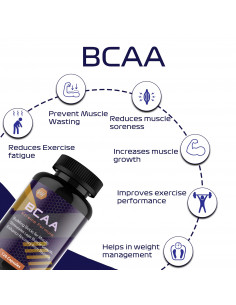- Supplement
- 3 likes
- 3534 views
As we all know from basic biology, Amino acids are the building blocks of proteins. Muscles size cannot grow without them. Vitaminhaat® L-Arginine is a conditionally essential amino acid and is a precursor for the production of Nitric Oxide. L-Arginine has been shown to promote increased nitric oxide which supports muscle development and recovery. amino acid build muscles.
Branched-chain amino acids, or BCAAs, are a special group of amino acids. They are some of the most proven athletic supplements one can take for direct assimilation. The benefits of BCAAs includes less muscle fatigue, higher levels of other free amino acids, faster recovery and better protein absorption. Not getting enough of them can lead to muscle loss.
Let’s take a closer look at how these supplements work and why you should include BCAA supplementation in your workout stack regimen. If your goal is to lose fat and transform your body, Vitaminhaat L-Carnitine would be a great addition to your weight loss supplement stack.
Amino Acids
Proteins are synthesized from long strings of molecules called amino acids.
Amino acids have many functions in our Body:
- Build new cells and repair tissues
- Create energy
- Take part in the enzyme and hormone system
- Build RNA and DNA the building blocks of life
- Synthesize antibodies to fight against infections
- Carry oxygen throughout the body
Amino acids are needed to build muscle, red blood cells, and hundreds of other molecules. The human body can produce all except 9 of them, which you have to get through your diet or supplementation. You can get them from eating protein or taking amino acid supplements.
The group of 9 amino acids the body can't produce are called essential amino acids. These include isoleucine, leucine, lysine, methionine, phenylalanine, threonine, tryptophan, histidine, and valine.
Non-Essential Amino Acids
- Alanine
- Arginine
- Asparagine
- Aspartic Acid
- Cysteine
- Glutamic Acid
- Glutamine
- Glycine
- Ornithine
- Proline
- Serine
- Tyrosine
Essential Amino Acids
- Histidine
- Isoleucine
- Leucine
- Lysine
- Methionine
- Phenylalanine
- Threonine
- Tryptophan
- Valine
Branched-Chain Amino Acids
The branched-chain amino acids are a group of three essential amino acids:
- Leucine
- Isoleucine
- Valine
The branched-chain group is different from other essential amino acids in that they are mostly metabolized in skeletal muscle instead of the liver.
References
- Layman, D. K. (2003). The role of leucine in weight loss diets and glucose homeostasis. The Journal of Nutrition, 133(1), 261S-267S.
- Holeček, M. (2002). Relation between glutamine, branched-chain amino acids, and protein metabolism. Nutrition, 18(2), 130-133.
- Houston, M. E. (2001). >Biochemistry Primer for Exercise Science. Human kinetics.
- van Acker, B. A., von Meyenfeldt, M. F., van der Hulst, R. R., Hulsewé, K. W., Wagenmakers, A. J., Deutz, N. E., ... &Soeters, P. B. (1999). Glutamine: the pivot of our nitrogen economy?Journal of Parenteral and Enteral Nutrition, 23(5_suppl), S45-S48.
- Häussinger, D., Gerok, W., Roth, E., & Lang, F. (1993). Cellular hydration state: an important determinant of protein catabolism in health and disease. The Lancet, 341(8856), 1330-1332.
- Häussinger, D. (1996). The role of cellular hydration in the regulation of cell function. Biochemical Journal, 313(Pt 3), 697.
- MacLean, D. A., Graham, T. E., &Saltin, B. (1994). Branched-chain amino acids augment ammonia metabolism while attenuating protein breakdown during exercise. American Journal of Physiology-Endocrinology and Metabolism, 267(6), E1010-E1022.
- Blomstrand, E., Hassmén, P., Ek, S., Ekblom, B., &Newsholme, E. A. (1997). Influence of ingesting a solution of branched‐chain amino acids on perceived exertion during exercise. ActaPhysiologica, 159(1), 41-49.
- Meijer, A. J., &Dubbelhuis, P. F. (2004). Amino acid signalling and the integration of metabolism. Biochemical and Biophysical Research Communications, 313(2), 397-403.
- Goldberg, A. L., & Chang, T. W. (1978, July). Regulation and significance of amino acid metabolism in skeletal muscle. In Federation Proceedings (Vol. 37, No. 9, pp. 2301-2307).
- Goto, M., Miyahara, I., Hayashi, H., Kagamiyama, H., &Hirotsu, K. (2003). Crystal structures of branched-chain amino acid aminotransferase complexed with glutamate and glutarate: true reaction intermediate and double substrate recognition of the enzyme. Biochemistry, 42(13), 3725-3733.
- Riazi, R., Wykes, L. J., Ball, R. O., &Pencharz, P. B. (2003). The Total Branched-Chain Amino Acid Requirement in Young Healthy Adult Men Determined by Indicator Amino Acid Oxidation by Use of l-[1-13C] Phenylalanine1. The Journal of Nutrition, 133(5), 1383-1389.
- Sapir, D. G., & Walser, M. (1977). Nitrogen sparing induced early in starvation by infusion of branched-chain ketoacids. Metabolism-Clinical and Experimental, 26(3), 301-308.
- Stepnick Gropper, S., &Plyler Johnson, A. (1994). Metabolic Effects of Ingestion of L-Amino Acids and Whole Protein. Journal of Nutritional Medicine, 4(3), 311-319.
- Mero, A. (1999). Leucine supplementation and intensive training. Sports Medicine, 27(6), 347-358.
- Mero, A., Pitkänen, H., Oja, S. S., Komi, P. V., Pöntinen, P., &Takala, T. (1997). Leucine supplementation and serum amino acids, testosterone, cortisol and growth hormone in male power athletes during training. The Journal of Sports Medicine and Physical Fitness, 37(2), 137-145.
- Shimomura, Y., Murakami, T., Nakai, N., Nagasaki, M., & Harris, R. A. (2004). Exercise promotes BCAA catabolism: effects of BCAA supplementation on skeletal muscle during exercise. The Journal of Nutrition, 134(6), 1583S-1587S.











